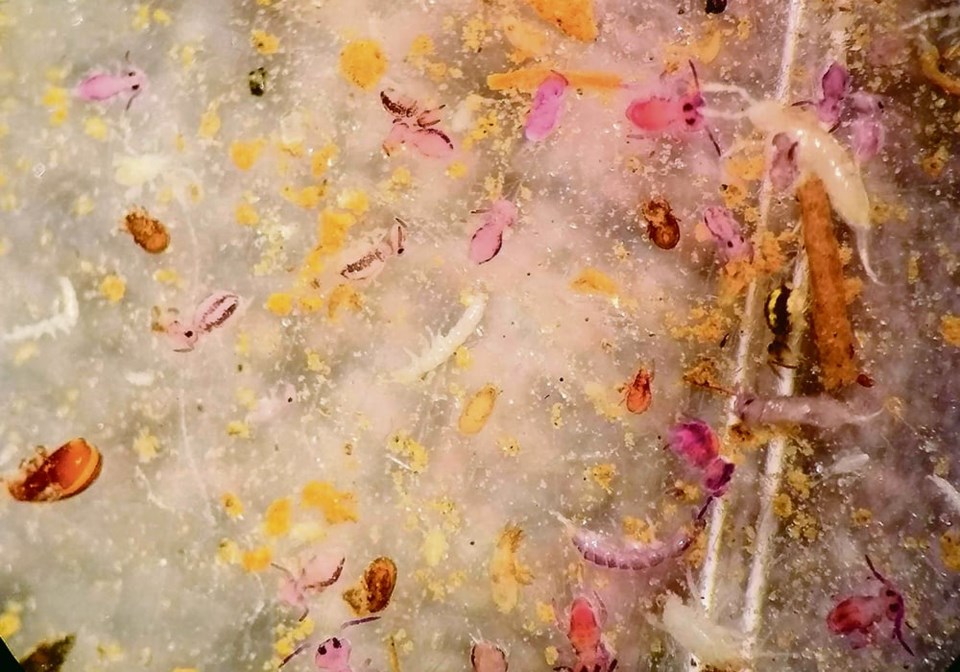WESTERN PRODUCER — Awareness of soil-borne bacteria benefits is growing. Prairie farmers increasingly incorporate commercially sourced biological agents in their agronomic plans. It’s an area where fresh soil research meets your seed drill.
Soil mesofauna have a major impact on at least a half dozen soil processes, which in turn impact crop production:
- impact soil organic matter decomposition
- promote nutrient cycling
- enhance plant pathogen suppression
- assist in seed germination
- enable root exudates secreted by plant roots
- manage plant nutrient allocation and growth
Soil mesofauna enhances crop production directly through these interactions with other components in the soil environment. Also, their indirect effect can add up to big impacts on crops, according to Ashley Jernigan, a PhD candidate in entomology at Cornell University.
“The most heavily studied area of microarthropod ecology is their effect on organic matter decomposition and nutrient cycling. Through feeding on resources in their environment, including organic matter, microarthropods enhance nutrient availability for crops,” Jernigan said.
“In addition to organic matter decomposition and nutrient cycling, they also affect seed germination, root exudates, plant pathogen suppression and transmission, plant nutrient allocation and growth. These effects are comparably less studied. Generally, having large balanced microarthropod communities benefits crop production through these different pathways.
“Soil microarthropods are classified as mesofauna based on their body size. This group is largely dominated by mites and collembolans, commonly called springtails. We are interested in their crop management abilities because they can provide different ecosystem services that can benefit crop production.”
In an email interview, Jernigan explained that microarthropods play a big role in regulating nutrient availability through interaction with microbial communities. However, high microarthropod populations can eat themselves out of house and home. They retard nutrient cycling if they over-graze microbes responsible for releasing nutrients into the soil. This is a less common occurrence in agricultural settings since certain crop management practices like tillage reduce microarthropod populations.
“Tillage is one way farmers alter the soil environment. Tillage typically reduces total mesofauna numbers. More intensive tillage causes a greater loss. However, certain species actually increase in abundance after a tillage event. This is because of the fact that microarthropods typically live in the top 10 to 15 centimetres of the soil. Shallow tillage tends to have less impact on the community overall. Farmers can reduce intensive tillage to increase their microarthropod populations.
“Any crop management practice that increases food resources for microarthropods is a benefit. This includes cover cropping, diversified crop rotations, incorporating inter-cropping and any type of organic matter input through fertilizer applications.
“Soil moisture makes the environment more hospitable for microarthropods. If water holding capacity of your soil is good for your crop, it is probably good for microarthropods. This may mean irrigating or adding tile drainage to control areas that get flooded.”
Jernigan said it’s more difficult to discuss pesticides in relation to microarthropod communities. She said pesticides negatively impact microarthropods, either directly through their modes of action or indirectly by affecting other environmental factors.
On the flip side of the coin, some compounds in pesticide formulations serve as a food source for certain microarthropod species. She said there needs to be more research in this area.
“The big takeaway for managing microarthropods and enhancing the ecosystem services they provide is to keep the soil environment as stable as possible and ensure they have adequate food resources.”
Meet the microarthropods
There are millions of microscopic mesofauna creatures that researchers call arthropods. They’re all crawling around in your soil core, blindly bumping into each other and interacting with crop roots.
At the heart of this subterranean meeting, we find the largest arthropod, which is two millimetres in size, about the size of a grain of salt. You can see these bugs with the naked eye.
At the other extreme, they go down in size to 100μm. One μm is one micrometre, also called a micron. It’s the metric measure equal to 0.001 mm. The micrometre is com- monly employed to measure the thickness or diameter of microscopic objects. These arthropods are very tiny, but don’t assume they’re not valuable. They are.
In the middle of this vast size range, we find the intermediate category of soil arthropods called microarthropods. This group of invertebrates is dominated by collembolans and mites.
The effect microarthropods have on crop production are typically explored with a focus on one soil process, such as nutrient cycling or plant pathogen disease incidence. Although the behaviour of microar- thropods influences many processes simultaneously, Ashley Jernigan is focusing her work on microarthropods.
You can no longer count on social media to deliver important news to you. Keep your news a touch away by bookmarking SASKTODAY.ca's homepage at this link.
Here's why you should bookmark your favourites.

